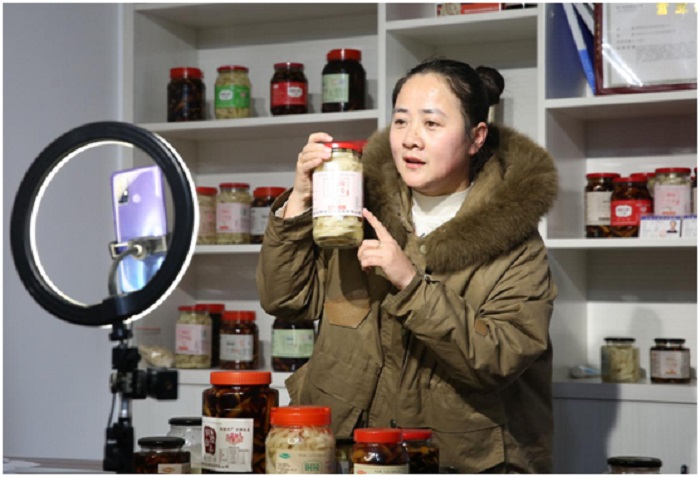



Thanks to e-commerce, Wang Bo, a post-90s young man in Huangling county, northwest China’s Shaanxi province, has bid farewell to poverty and embraced a bright new life over the past several years.
The life-changing story of Wang, who was once a registered poor villager and now a role model in shaking off poverty through e-commerce, started in 2016 with several photos of ripe apples he posted on WeChat Moments.
To his surprise, these photos of apples from the orchard of his family attracted buyers to him. Since then, the man has won an increasing number of customers because of his high-quality products and good reputation.
As the local information network infrastructure continuously improves, Wang joined an e-commerce incubation base in Huangling county under the support of local government.
He then established a village-level e-commerce service station, an e-commerce company, and a cooperative for the planting of fruit trees. While seeing great changes to his own life, Wang has also helped his fellow villagers become better off.
In rural areas of China, more Internet users like Wang are doing business on the Internet. The country’s increasingly fast Internet connections and constantly improving network services have provided strong support for the new group of netizens.
Statistics show that since 2015, China has implemented six batches of pilot projects for universal telecommunications services, and supported a total of 130,000 administrative villages in 27 provinces (autonomous regions and municipalities) across the country in carrying out broadband network construction and upgrading, including 43,000 registered poverty-stricken villages.
Over 98 percent of the administrative villages in China have been covered by fiber-optic and 4G networks. As of the end of 2020, the total number of rural broadband users in China reached 142 million.
The Internet Plus model in China has also altered the traditional agricultural production model that depends greatly on natural conditions.
In a pear planting base in Chongming district of east China’s Shanghai, where more than 50 pieces of high-tech equipment run automatically every day, farmers can check the condition of fruit trees in the base via their mobile phones with the help of unmanned aerial vehicles.
The digital agriculture base is using robots to winter wash and sterilize fruit trees and spray pesticide over them for the control of diseases and pests. Meanwhile, it has adopted an integrated water and fertilizer irrigation system, which could automatically mix water with fertilizer according to a preset ratio.
The pear planting base is the first project implemented by e-commerce platform Hema Fresh, Alibaba’s fresh-food chain, in Chongming district since the platform established strategic cooperative ties with the government of the district. It supplies products directly to the online and offline sales channels of Hema Fresh.
Various sensors in the base can automatically collect data indicating such factors that affect the growth of the pear as temperature, humidity, carbon dioxide concentration, light intensity, soil fertility, and salt concentration and upload on to and store relevant information on an Internet of Things (IoT) cloud platform, according to Zhang Yangping, a technical executive at the base.
Based on data analyses, experts build models and offer guidance on farming to improve the quality of pears, Zhang said, disclosing that last year, the output value of high-quality pears produced at the base reached 15,000 yuan (about $2,306) per mu (about 667 square meters).
China will implement projects to boost rural development via digital technologies, advance the development of smart agriculture, and establish a big data system for the agricultural sector and rural areas, according to guidelines on pushing forward all-round rural vitalization and accelerating the modernization of the agricultural sector and rural areas jointly issued by the Communist Party of China (CPC) Central Committee and China’s State Council.
The country will also make efforts to promote the in-depth integration of new-generation information technology into agricultural production and management, and strengthen the application of digital and intelligent technologies in rural public services and social governance, said the document.
It’s believed that by tapping into the Internet Plus model, China is bound to realize all-round rural vitalization and ensure that rural areas have strong agriculture, beautiful countryside and well-off farmers.


The Humanitarian Service Diamond Awards has.
A Chinese Company, Inner Galaxy Steel.


The Programme Coordinator, Regulatory, Compliance and.


A Non-Governmental Organization (NGO), Committee for.
The Trustfund Pensions Limited has chided.


The House of Representatives Committee on.
The China General Chamber of Commerce.


Senator Chuka Utazi who represented Enugu.


An Abuja based Legal Practitioner, Ugochukwu.


The African business community in Yiwu,.
Leave a Comment